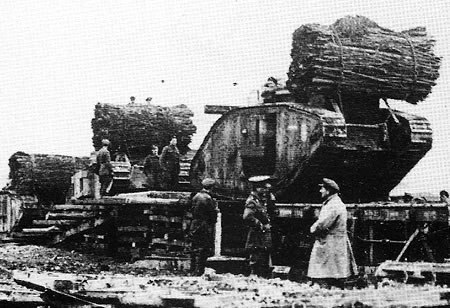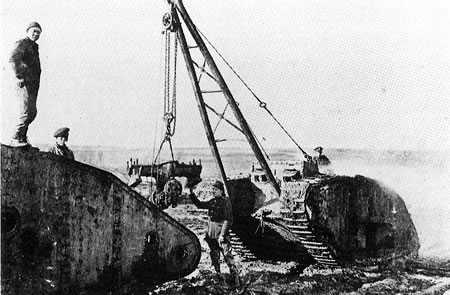While the use of tanks in France and Belgium may not have being a roaring success to begin with, or at least not as big a success as was hoped, they did fare rather better in the less muddy conditions of the Middle-East, fighting the Turkish Army at Gaza in Palestine.
The Turkish were eventually successfully attacked using old Mark I tanks, which crossed dried up riverbeds and gullies with ease. The first wave of eight Mark I’s of April 1917 didn’t fare so well, and in fact took heavy losses, but the Third Battle of Gaza in November was much more successful. However, the successes in the Middle-East were not considered too noteworthy as the Western Front, much closer to home, was considered to be of far greater importance and, in fact, it was in France the tanks started to make an impression after countless drawbacks and failures.
 After the fighting at Ypres was over, staff officers of the Tank Corps began to lay special plans with new tactics, involving every available tank, for attacking a robust stretch of the German Hindenburgh Line. The German trenches were very wide by this time, so the British had devised a simple system to fill in the trenches with large bundles of brushwood or fascines, dropped into the trenches by the tanks. The bundles weighed about 1 ½ tons and allowed the tanks to drive over them and cross the trench.
After the fighting at Ypres was over, staff officers of the Tank Corps began to lay special plans with new tactics, involving every available tank, for attacking a robust stretch of the German Hindenburgh Line. The German trenches were very wide by this time, so the British had devised a simple system to fill in the trenches with large bundles of brushwood or fascines, dropped into the trenches by the tanks. The bundles weighed about 1 ½ tons and allowed the tanks to drive over them and cross the trench.
Not far from the town of Cambrai, along a line stretching for six miles (10 km), 447 British tanks made ready for attack on November 20th 1917. The attack began with a briefer artillery bombardment than usual so as to not overly damage the battlefield with shell holes in order to make it easier for the tanks to cross. The tanks trundled slowly across the front with accompanying soldiers and, in a time when gaining a matter of feet was commonplace, allied troops took an astonishing 7 (11 km) miles of land from the Germans in one week. Unfortunately though, the tanks had taken a hell of a beating so that the soldiers were left with no support by the end of it and the Germans took back nearly all the ground they’d lost. However, the initial success at Cambrai was an excellent demonstration of how effective tanks can be, so long as you have enough of them or they don’t get blown to pieces, and helped renew the vigor in Britain for designing new models of tank.
Another interesting war machine was developed alongside the tank during the First World War, that of the mobile, or self-propelled gun. The Gun Carrier Mark I was simply an adaptation of the Tank Mark I, designed to carry a 6 inch (152 mm) Howitzer or a sixty-pounder gun that could be winched onto an open platform at the front. Forty-eight of these new weapons were shipped to France in June 1917, the first of many to follow.
 The mobile gun couldn’t have come at a better time. In the early period of the First World War one of the chief uses of airplanes was to spot enemy gun emplacements. Pilots would circle enemy guns and allied artillery would try and hit them. The pilot had a one-way communicator with the artillery in the form of a clicker device that sent primitive radio signals, for which they had different codes in use to signal the artillery how far out and in what direction they were missing the target. Once they were on target the whole artillery barrage would open fire on that point. It was actually because of this that dogfights were born, in that enemy planes would have to go up and shoot down the spotters to protect their own artillery and other targets. It is easy to see how having a mobile Howitzer can be a huge advantage because you could move your guns periodically to keep the enemy guessing where to look for them. The early Gun Carrier Mark I’s had the same engine and transmission as the Tank Mark I, housed in the back. With the driver and breakman sat in armored cabins at the back of the gun, they could position themselves to shell German trenches then move someplace else before enemy spotters could find them.
The mobile gun couldn’t have come at a better time. In the early period of the First World War one of the chief uses of airplanes was to spot enemy gun emplacements. Pilots would circle enemy guns and allied artillery would try and hit them. The pilot had a one-way communicator with the artillery in the form of a clicker device that sent primitive radio signals, for which they had different codes in use to signal the artillery how far out and in what direction they were missing the target. Once they were on target the whole artillery barrage would open fire on that point. It was actually because of this that dogfights were born, in that enemy planes would have to go up and shoot down the spotters to protect their own artillery and other targets. It is easy to see how having a mobile Howitzer can be a huge advantage because you could move your guns periodically to keep the enemy guessing where to look for them. The early Gun Carrier Mark I’s had the same engine and transmission as the Tank Mark I, housed in the back. With the driver and breakman sat in armored cabins at the back of the gun, they could position themselves to shell German trenches then move someplace else before enemy spotters could find them.
However, most of these original mobile guns were seen to be the ideal shape, with the gun removed, and strength for carrying large and heavy supply loads, which is what most of them ended up doing. Other tank modifications included excavators for digging and filling trenches, and even specially adapted salvage vehicles for hauling back the burned out hulks of countless wrecked tanks.